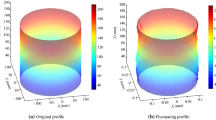Abstract
Ellipsoid part is now increasingly applied to the product manufacturing, while the high-quality ellipsoid part depends not only on the manufacturing and machining techniques, but also on the adopted measurement and evaluation approaches. Based on the typical quadratic surface, an evaluation method of the least squares ellipsoid deviation is proposed in this paper to quantify the form deviation of measured ellipsoid. The method can overcome the weakness of the low measurement adaptability compared with other evaluation methods. With obtaining the coefficients of surface equation to replace the linear superposing of the coordinates of measured points, the measurement error existing in the coordinates of measured points is homogenized and reduced effectively, which prompts to obtain the accurate measurement result. Finally, the results from experimental verifications show that the proposed method is effective for the measurement and evaluation of the ellipsoid deviation in Cartesian coordinates, and the adaptability is also a significant advantage in the measurement and evaluation of geometry deviation.







Similar content being viewed by others
References
Shi, Z., Zhang, H., Tang, J., et al. (2014). On the anisotropy of surface measurement. Journal of Mechanical Engineering, 50(18), 1–6.
BS EN ISO 1101. (2013). Geometrical product specifications (GPS). UK: The Standards Policy and Strategy Committee.
ISO 17450-1. (2011). Geometrical product specifications (GPS)-General concepts—Part 1: Model for geometrical specification and verification. Switzerland: International Standardization Organization.
ISO 17450-2. (2012). Geometrical product specifications (GPS)-General concepts—Part 2: Basic tenets, specifications, operators, uncertainties and ambiguities. Switzerland: International Standardization Organization.
Liao, P. (2009). Calculation of elliptic sphere form error based on genetic algorithm. Chinese Journal of Scientific Instrument, 30, 780–785. (in Chinese).
Zhang, L., Zhang, Z., Zhang, Z., et al. (2015). Calcuiation of elliptic sphere profile error using the combination of the DGA and the PSO algorithm. Acta Metrologica Sinica, 36(6), 584–587. (in Chinese).
Forbes, A. B., Lam, J., & Tomlins, P. (2009). Capturing local and anisotropic behaviour in surface topography. Wear, 266, 527–529.
Liu, F., Xu, G., Liang, L., et al. (2016). Least squares evaluations for form and profile errors of ellipse using coordinate data. Chinese Journal of Mechanical Engineering, 29(5), 1020–1028.
Kanatani, K., & Rangarajan, P. (2011). Hyper least squares fitting of circles and ellipses. Computational Statistics & Data Analysis, 55, 2197–2208.
Ahn, S. J., Rauh, W., & Warnecke, H. J. (2001). Least-squares orthogonal distances fitting of circle, sphere, ellipse, hyperbola, and parabola. Pattern Recognition Letters, 34, 2283–2303.
Chaudhuri, D. (2010). A simple least squares method for fitting of ellipses and circles depends on border points of a two-tone image and their 3-D extensions. Pattern Recognition Letters, 31, 818–829.
Lei, X., Gao, Z., Cui, J., et al. (2015). The minimum zone evaluation for elliptical profile error based on the geometry optimal approximation algorithm. Measurement, 75, 284–288.
Tu, X., Lei, X., Wang, S., et al. (2015). The minimum zone method of fitting and error evaluation for ellipsoidal surface located at arbitrary position in space. Machinery Design and Manufacture, 8, 262–266. (in Chinese).
Liu, F., Xu, G., Liu, D., et al. (2017). Sampling strategy and error estimation for evaluation of quadratic form error using cartesian coordinate data. IET Science, Measurement and Technology, 11, 839–846.
ASME Y 14.5 M. (1995). Dimensioning and Tolerancing. New York: The American Society of Manufacturing Engineers.
DD CEN ISO/TS12181-1:2007. (2008). Geometrical product specifications (GPS)—Roundness—Part 1: Vocabulary and parameters of roundness. UK: The Standards Policy and Strategy Committee.
DD CEN ISO/TS12181-2:2007. (2008). Geometrical product specifications (GPS)—Roundness—Part 2: Specification operators. UK: The Standards Policy and Strategy Committee.
Li, X., & Shi, Z. (2010). Evaluation of roundness error from coordinate data using curvature technique. Measurement, 43(2), 164–168.
Fei, Y. (2010). Error theory and data processing (2nd ed.). Beijing: China Machine Press.
Acknowledgements
This research is supported by the National Natural Science Foundation of China (Grant 51775423), the National Key Research and Development Program of China (Grant 2018YFB2000202), the China Postdoctoral Science Foundation (Grants 2017M623159 and 2018T111046), the Postdoctoral Science Foundation of Shaanxi Province (Grant 2017BSHEDZZ68), the Fundamental Research Funds for the Xi’an Jiaotong University (Grant XJJ2018047).
Author information
Authors and Affiliations
Corresponding author
Additional information
Publisher's Note
Springer Nature remains neutral with regard to jurisdictional claims in published maps and institutional affiliations.
Rights and permissions
About this article
Cite this article
Liu, F., Liang, L., Xu, G. et al. Measurement and Evaluation of the Ellipsoid Deviation in Cartesian Coordinates. Int. J. Precis. Eng. Manuf. 21, 2077–2088 (2020). https://doi.org/10.1007/s12541-020-00408-7
Received:
Revised:
Accepted:
Published:
Issue Date:
DOI: https://doi.org/10.1007/s12541-020-00408-7



